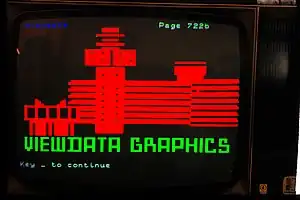
Viewdata Graphics used in the experimental phone directory of Post Office Telecommunications in 1977.
The image is a graphical representation of the Post Office/British Telecom Research laboratories (Adastral Park) in Suffolk, England.
The image is a graphical representation of the Post Office/British Telecom Research laboratories (Adastral Park) in Suffolk, England.
Samuel Fedida, OBE (4 May 1918 – 2007) was an Egyptian-born British telecommunication engineer responsible at Post Office Telecommunications for the development of Viewdata.[1]
Fedida was born in Alexandria, Egypt.[2] He had the idea for Viewdata in 1968 after reading a publication with the title The Computer as Communications Device.[3] The first prototype became operational in 1974. In 1977 the system was introduced in the United Kingdom. He was appointed an Officer of the Order of the British Empire in the 1980 Birthday Honours.[4]
The book Viewdata Revolution authored by Mr Fedida and Mr Rex Malik, ISBN 0852272146, was published in 1979, and is listed in the main catalogue of The British Library.
References
- ↑ Lean, Tom (23 August 2016), Prestel: The British Internet That Never Was, History Today
- ↑ New York State, Passenger and Crew Lists, 1917-1967
- ↑ Licklider, J.C.R.; Taylor, Robert W. (April 1968), "The Computer as a Communication Device" (PDF), Science and Technology
- ↑ "No. 48212". The London Gazette (Supplement). 13 June 1980. p. 10.
Sources
- "Patent: Information handling system and terminal apparatus therefore". Archived from the original on 10 July 2012. Retrieved 13 December 2009.
- "US-Gericht sieht in Nutzung von Hyperlinks keine Patentrechtsverletzung" (in German). Retrieved 13 December 2009.
- Eric Somers (May 1983). "A user's view of Prestel". Creative Computing. 9 (5): 123.
- "Fanfare for Prestel". Retrieved 13 December 2009.
- "A Short History of Prestel". Retrieved 13 December 2009.
- Infoworld Media Group, Inc (1982). "Prestel: gateway to world of electronic communication". InfoWorld: 9.
- Infoworld Media Group, Inc (1979). "Viewdata '80 To show Many Teletext Systems". InfoWorld: 3.
- Otfried Georg. - 2., völlig neubearb. und erw. Aufl. (2000). Telekommunikationstechnik: Handbuch für Praxis und Lehre. Berlin: Springer. p. 28. ISBN 978-3-540-66845-9.
{{cite book}}: CS1 maint: numeric names: authors list (link) - James Gillies & Robert Cailliau (2000). How the Web was born: the story of the World Wide Web. Oxford: Oxford University Press. p. 106. ISBN 978-0-19-286207-5.
This article is issued from Wikipedia. The text is licensed under Creative Commons - Attribution - Sharealike. Additional terms may apply for the media files.